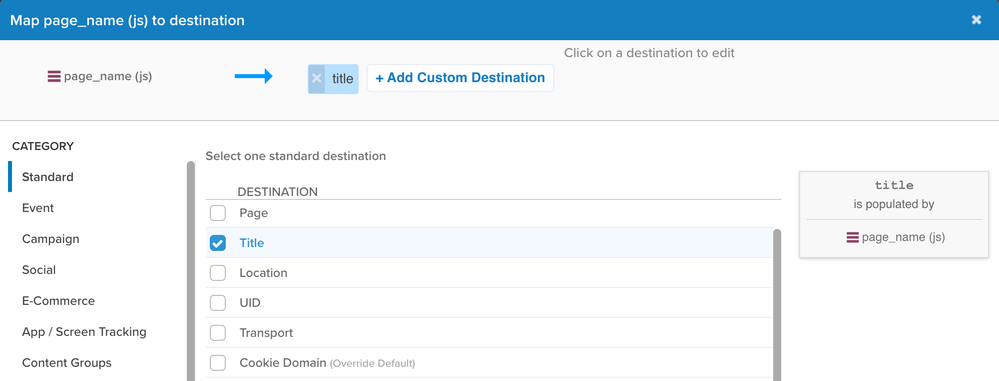About data mappings
This article describes how to configure tag data mappings to send data from your data layer to a vendor.
A data mapping is a connection between a data layer variable and a vendor tag. Data mappings determine the data a tag receives and the type of event tracking it performs.
For example, a tag might collect the page name in a parameter named pName, but your data layer might store this value in a variable named page_name. To send the value of page_name to pName, you create a data mapping. After the mapping is configured, the value of page_name will always be passed to the vendor parameter pName when that tag is triggered.

Data mappings are managed from the tag configuration. The list of supported vendor parameters is organized by category and available on the Data Mappings screen. First, you select the data layer variable to map, then choose the vendor parameter it maps to.

Variable mapping
There are two types of data mappings: variable mappings and custom value mappings. A variable mapping is the most common type since it allows values from your data layer to be passed to a vendor parameter.
Event mapping
An event mapping is a variable mapping that associates your event names to the vendor’s event names. For example, an e-commerce tag might run specific tracking functions for each of the primary shopping actions, such as searching for products, viewing product details, adding a product to the cart, checking out, and completing a purchase.
The vendor tag might offer the following tracked events for an e-commerce site:
viewItemviewSearchResultaddToCartviewCartcompleteTransaction
Similarly, your data layer might track these same events using tealium_event and the following values:
product_viewsearchcart_addcart_viewpurchase
An event mapping associates the values of your event variable ( tealium_event ) to the vendor’s event names and triggers the corresponding tag function. Learn more about mapping events.
Example: Variable mapping
A tag vendor has a parameter for currency code, named curr , to be set to the three-character code matching the currency of a transaction. If the tag is loaded on pages that support multiple currencies, you would likely have a data layer variable called site_currency or currency_code that is set to the appropriate value for the current visitor. The expected values might be USD, CAD, GBP, EUR, JPY, and so on. The variable mapping would look like this:

Custom value mapping
A custom value mapping is a convenient method for assigning a value directly in a mapping without using an extension or a data layer variable. The custom value is plain-text or the return value of a snippet of JavaScript code.
Example: Custom value with plain text
A tag vendor has a parameter for currency code, named curr , but the tag is only deployed to a single geographic region where the currency is always the same (such as CAD). In this case, a data layer variable is not necessary because the value is constant throughout the site. The expected currency code, CAD, can be set directly as a custom value mapping, as follows:

Example: Custom value with JavaScript code
The custom value can also be returned from JavaScript code. This option can be used to pass a JavaScript number, boolean, or array value to a vendor parameter. You can use advanced statements or even an inline function.
For example, the following line of JavaScript sets the mapping to GB if the hostname contains co.uk, otherwise it is set to USD:
location.hostname.indexOf("co.uk") > -1 ? "GBP" : "USD"

To reference a data layer variable such as page_name, use the b object. For example, b['page_name']. Learn more about the b object.
Mapping precedence
When two or more variables are mapped to the same destination, such as page_name > pageName and Document Title > pageName, the last mapping takes precedence. Data mappings can be reordered to account for this precedence.

In this example, if both page_name and Document Title are populated, the destination variable pageName will receive the value from Document Title. If the variables are populated, the last mapping takes precedence.
Learn more about reordering data mappings.
If a variable does not have a value, the mapping is not applied.
This page was last updated: January 2, 2024